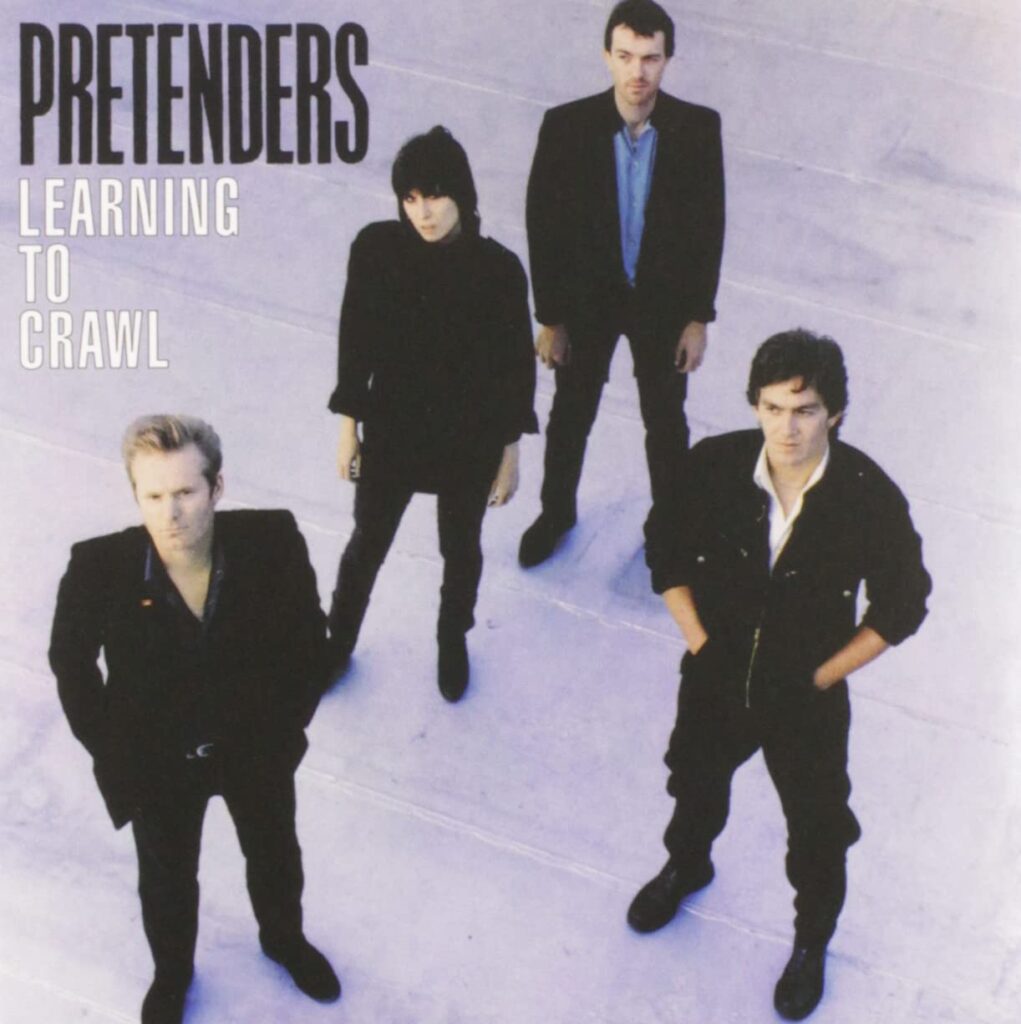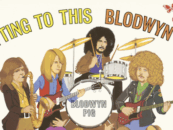 The third Pretenders album, Learning to Crawl, took shape over 14 turbulent months as founder and frontwoman Chrissie Hynde faced literal life and death challenges: the birth of her daughter and the fatal overdoses of two original bandmates. Mortality and motherhood emerged as themes shaping the set, deepening Hynde’s artistry as a songwriter and reinforcing her command over the band’s identity.
The third Pretenders album, Learning to Crawl, took shape over 14 turbulent months as founder and frontwoman Chrissie Hynde faced literal life and death challenges: the birth of her daughter and the fatal overdoses of two original bandmates. Mortality and motherhood emerged as themes shaping the set, deepening Hynde’s artistry as a songwriter and reinforcing her command over the band’s identity.
The album’s critical and commercial triumphs were redemptive after the original quartet’s unraveling in 1982. Over that summer, the band that expat American singer, songwriter and guitarist Hynde had assembled four years earlier collapsed over the course of three days, beginning on June 14 when Hynde, guitarist James Honeyman-Scott and drummer Martin Chambers fired bassist Pete Farndon over his escalating heroin use. Two days later, Honeyman-Scott was found dead in his girlfriend’s apartment. Cause of death was listed as “heart failure due to cocaine intolerance.” He was 25 years old. Exiled from the band, Farndon would follow, dying from an overdose on April 14, 1983, at the age of 30.
Internal pressures had built since the quartet’s incendiary 1979 debut album catapulted them to platinum success with its savvy, punk-adjacent alloy of rock influences. For a young band with style to burn but a relatively bare cupboard of new songs, their success demanded juggling live dates with isolated studio sessions as they bought time with two singles and an EP before delivering 1981’s sophomore set, Pretenders II, a merely good album that broke little new ground beyond its front-loaded singles, “Talk of the Town” and “Message of Love.” The group then toured the U.S., Japan and Australia during the first quarter of 1982, playing a final date in Bangkok in early April as the rift with Farndon deepened. In her 2015 memoir, Reckless—My Life as a Pretender, Hynde would recall the last shows as “going through the motions—the worst possible thing for a band.”
For Hynde, that showdown was compounded when she became pregnant by fiancé Ray Davies, the Kinks’ own frontman and the author of The Pretenders’ first single, “Stop Your Sobbing,” as well as “I Go to Sleep” on Pretenders II. It’s a testament to Hynde’s resilience that she pushed through those challenges, rallying from the loss of her bandmates, to head back into the studio five weeks later to record a new single.
In both content and execution, “Back on the Chain Gang” channeled her grief over the death of Honeyman-Scott, whose influence and inspiration had been crucial to her own creative growth. To fill that role, she tapped guitarists Billy Bremner, the affable Scot then best known as Dave Edmunds’ six-string foil in Rockpile, and Robbie McIntosh, whom Honeyman-Scott had approached as a potential new band member. Joining them and drummer Chambers was Big Country bassist Tony Butler, already down the hall at AIR Studios for sessions with his band.
In a 2009 interview, Hynde remembered writing while she was “traumatized at the loss of my two best friends.” Honeyman-Scott’s legacy did help her cast new players, choosing guitarists “who Jimmy would have wanted to get in, so I didn’t need to think about it.” Both Bremner and McIntosh bring a lighter, lyrical touch to their playing, earmarked by the circular single-note motif with which Bremner leads off the song; Hynde’s pensive lyrics mirror its tumultuous backstory in a “circumstance beyond our control” that “hijacked [her] world.” The song’s major key melody and buoyant mid-tempo pace belie trace elements of grief as she mourns the lost “happiest days of my life.”
The arrangement nods to Sam Cooke’s classic 1960 hit, “Chain Gang,” in her bandmates’ background vocal grunts and the percussive ring of hammer blows, welding its tribute to Honeyman-Scott with an anthem of perseverance. “Back on the Chain Gang” was a turning point in Hynde’s writing, revealing a new maturity and depth of feeling. Released as a single on September 17, 1982, the song would become the Pretenders’ biggest U.S. hit and one of their most enduring tracks.
In navigating past her band’s tragic upheaval, Hynde moved beyond the glam swagger of her early hits and dialed back the erotic provocation heard on the debut album and continued with “The Adulteress” and “Bad Boys Get Spanked” on Pretenders II. The songwriter’s social and political radar had been activated years earlier as she witnessed the traumatic May 4, 1970, shootings at Ohio’s Kent State University, where she was a student. She later fled the conformity of her hometown of Akron, but Christine Ellen Hynde hadn’t severed family ties, and on subsequent visits home she saw how rampant development and the loss of industrial jobs had hollowed out the city’s economy and sacrificed its rural beauty, losses she exposed in the sessions’ next creation.
Related: Our Album Rewind of the Pretenders’ debut
“My City Was Gone” serves as an epitaph for the Akron of her youth, scarred by overdevelopment and environmental damage. Opening with Tony Butler’s stalking bass line and stabbed by tense bursts of guitar from Bremner, the track gauges how “the farms of Ohio had been replaced by shopping malls, and Muzak filled the air.”
Watch the group perform “My City Was Gone” at the Rock and Roll Hall of Fame in 2005, with Neil Young
Released as the B-side to “Back on the Chain Gang,” “My City Was Gone” would receive an ironic boost on Rush Limbaugh’s conservative EIB Network, which adopted its intro as a theme song without permission. Limbaugh relished the subversion of an “anti-conservative” song penned by “an environmentalist, animal rights wacko” but pulled the track after a legal challenge. More surprising, but reflective of her own unsentimental pragmatism, Hynde herself reversed the challenge because her parents were Limbaugh fans. She granted the far-right firebrand access for his support of PETA, the animal rights organization that she championed. A usage payment was negotiated allowing Limbaugh to continue using the rights for a year, with revenues donated to PETA.
Another interim crew was tapped for the album’s lone cover of “Thin Line Between Love and Hate,” an R&B ballad originally recorded by the Persuaders in 1971, featuring Bremner, bassist Andrew Bodnar from the Rumour and veteran keyboard player Paul Carrack (Ace, Squeeze, Roxy Music, Mike and the Mechanics). Hynde and Chambers then established a more durable lineup with McIntosh and new bassist Malcolm Foster. Producer Chris Thomas, their studio shepherd since the debut, earned Hynde’s thanks as “fifth Pretender” for his skill as a demanding taskmaster who had worked with an honor roll of major artists since honing his skills as a self-appointed disciple of George Martin, beginning with sessions for the Beatles’ eponymous “white album.” Hynde found him “high-strung and cantankerous,” and was “terrified of pissing him off,” evidence of his skill at manipulating his clients to extract solid performances from artists ranging from Pink Floyd and Procol Harum to Roxy Music, the Sex Pistols, Elton John, Pete Townshend, INXS and Pulp.
With Pretenders 2.0 now in place, album sessions further explored Hynde’s post-punk gravitas as she transitioned from rock ’n’ roll vixen to bandleader, songwriter and now mother to daughter Natalie, signaling those roles as well as her street-level world view on “Middle of the Road,” a tough rocker that would open the finished album and serve as a lead-in single released in November ’83, prior to the LP’s January 13, 1984 release. Drummer Chambers primes the track with a quick, hard flurry of tom-tom strikes before launching the quartet on a brisk ride surveying Hynde’s clear-eyed take “standing in the middle of life with my plans behind me.”
The new lineup’s lean attack showcases McIntosh’s taut guitar work and Foster’s sturdy bass lines as Hynde flexes multiple metaphors from the title: “In the middle of the road, you see the darnedest things,” she reports before contrasting “fat guys…wearing big diamond rings and silk suits” with “corrugated tin shacks full up with kids,” a snapshot of inequality tied to her adopted English home’s colonial past. “When you own a big chunk of the bloody third world, the babies just come with the scenery.”
After a molten guitar solo from McIntosh, Hynde issues a tart warning-cum-plea to leave her alone. “I’m not the cat I used to be, I got a kid, I’m thirty-three” serves as an unsentimental break from her earlier image, visualized on a cover portrait that shows the band cloaked in workmanlike black jackets and slacks, a far cry from the stylish leather modeled on the first two LP sleeves.
Motherhood’s influence starts with the album title, which doubles as commentary on Hynde’s need to rebuild the Pretenders with new blood, with two other tracks addressed to her child. Released as the album’s third single, “Show Me” is an uptempo love song echoing “Kid” on the band’s debut album musically and thematically; where “Kid” imagined a prostitute’s conversation with her child, “Show Me” is Hynde’s heartfelt meditation on the depth of her feelings for Natalie. The singer mingles adoration with the struggle to reconcile a world of “wars, disease and brutality” with her child’s “innocence and grace” and with love itself.
“Thumbelina” follows as a more lighthearted valentine, taking its title from the miniature heroine of Hans Christian Andersen’s fable, and delivered as a lullaby in motion, a view of America as seen from the windows of her tour bus. McIntosh propels the track with nimble electric country accents as Hynde pledges her love and protection along the broken highway line from Tucson to Amarillo.
Overall, Hynde’s songs nudge the band’s core style toward more melodic pop elements, softening the often-brutal energy that had animated the debut while making room for two songs that revisit the harder, angular attack and shifting time signatures plied on the first two LPs. “Time the Avenger” is a remorseless portrait of a white-collar scoundrel whose self-absorption will doom him to ruin.
Hynde then kicks the Pretenders into higher gear on “Watching the Clothes,” a droll romp that documents a mundane Saturday night at the laundromat with winking social commentary (“There go the whites, getting whiter…/There go the colors, getting brighter…”) and adds a welcome levity amid the album’s darker moments.
The balance of diversity and consistency achieved across Learning to Crawl helped the band rebound to platinum stature, with the set spawning five singles, a long tail in catalog sales and perpetual radio and streaming airplay. Hynde’s insistence that she was “not sentimental” was belied by the tenderness of her nods to her daughter, as well as by the album’s atmospheric final track, “2000 Miles,” a wistful ballad of yearning for a distant lover as Christmas approached. With its hushed but vast sonic space and seasonal images of singing children, the song was released in the U.K. in November 1983 as a holiday single, ahead of the album’s planned release early in the new year, going on to a long life as a holiday perennial and capping the album’s achievement as arguably her band’s zenith.
Beginning with Learning to Crawl, Hynde solidified her command of the Pretenders, guiding the band through personnel changes that periodically left her as the lone alum from the original quartet. “I always said that if one of us left, it wouldn’t be the Pretenders anymore,” she remembered in her memoir, yet “never talked about changing our name” after 1982’s daunting losses. “I kept the band going, loosely speaking. Different lineups and producers have seen me through and it’s always a pleasure to do the old songs.”
Yet the ghosts of the founding foursome would linger. Hynde ends her memoir with the death of Pete Farndon, her ex-lover, former bass player and cautionary victim of a lifestyle that she would renounce. In the book’s epilogue, she invokes the influence of Honeyman-Scott, who “[made] me more than I could have ever been on my own.” For years afterward, she “found that any musical question I had could easily be answered. I just had to imagine what Jimmy would do.”
Pretenders’ extensive catalog is available in the U.S. here and in the U.K. here.
Watch Chrissie Hynde perform “Back on the Chain Gang” live in Hyde Park in 2014, for BBC 2 Radio
Tickets to see them are available here and here.
- ‘Running on Empty’: Jackson Browne’s Romance of the Road - 12/06/2025
- ‘Slowhand’: Eric Clapton’s 1977 Platinum Balancing Act - 11/25/2025
- Stephen Stills’ A-List Solo Debut Revisited - 11/16/2025







2 Comments so far
Jump into a conversationLTC kicks ass from start to finish. I remember thinking the second album was just OK. Loved the music video for “Middle of the Road”.
“Back on the Chain Gang” came out so far in advance of the album that you almost forgot about it.
Unless you were one of the few people to see the vastly under-appreciated “King Of Comedy”, and heard it during the credit roll.
Interesting how their best album came in the aftermath of all the tragedy. Coincidentally, I have a segment of “songs from the ’80s that were covers of older songs” on my weekend radio show that I just uploaded last night, and “Thin Line Between Love and Hate” is in that segment.